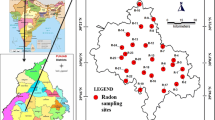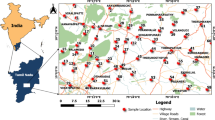Abstract
Salinity, water logging, high nitrate, fluoride and dissolved uranium concentration in drinking water of southwest Punjab has impacted the local population leading to health issues and additional burden on economy. Though it was known that both U and its daughter products especially Rn contribute to radiological dose to the population through drinking water, there were no correlation studies carried out between these radioactive elements in U impacted regions of southwest Punjab. In this study, an initiative has been taken to assess the doses due to dissolved radon in drinking water. In addition, the U–Rn couple is evaluated in detail along with other hydrochemical parameters. The radon concentration ranges from 360–1700 Bq/m3 for Faridkot and 140–1400 Bq/m3 for Muktsar for both seasons and the related average total dose due to radon for both season of Faridkot and Muktsar are 9.79 µS/year and 7.74 µS/year respectively. The total dissolved uranium is in range of 16–350 µg/L for Faridkot and 14–106 µg/L for Muktsar for both seasons. An inverse correlation was observed between Rn and U, which could be attributed to diverse geochemistry of U and Rn in groundwater.










Similar content being viewed by others
Explore related subjects
Discover the latest articles and news from researchers in related subjects, suggested using machine learning.References
USEPA (1999) Radon in drinking water, factsheet. EPA815-F-99-007, United States Environmental Protection Agency. http://water.epa.gov/scitech/drinkingwater/dws/radon/qal.cfm. Accessed 20 Nov 2018
Mill WA (1990) Risk assessment and control management of radon in drinking water. In: Cothern CR, Rebers P (eds) Radon, radium and uranium in water. Lewis Publishers, Chelsea, pp 27–37
NRC (1999) Risk assessment of radon in drinking water. National Resource Council, Washington, D.C
Darby S, Hill D, Auvinen A, Barros-Dios JM, Baysson H, Bochicchio F, Deo H, Falk R, Forastiere F, Hakama M, Heid I (2005) Radon in homes and risk of lung cancer: collaborative analysis of individual data from 13 European case-control studies. BMJ 330(7485):223–228
https://pubchem.ncbi.nlm.nih.gov/compound/radon#section=Solubility
IARC (1988) Monographs on the evaluation of the carcinogenic risk of chemicals to humans. vol 173. World Health Organization, International Agency for Research on Cancer, Geneva, 1972-PRESENT (Multivolume work), p. V43. http://monographs.iarc.fr/ENG/Classification/index.php
Beach L (1984) Exposure from the uranium series with emphasis on radon and its daughters, report no. 77. National Council on Radiation Protection and Measurements Bethesda, NCRP, Bethesda, p 131
USEPA (2012) Radon in drinking water, factsheet. EPA 815-R-12-002 (https://archive.epa.gov/water/archive/web/pdf/epa815r12002.pdf). Accessed 20 Nov 2018
USEPA (2005) Current drinking water standards, US Environmental Protection Agency Office of Water. http://www.epa.gov/safewater/. Accessed 20 Nov 2018
Abdurabu WA, Ramli AT, Saleh MA, Heryansyah A (2016) The activity concentrations of 222Rn and corresponding health risk in groundwater samples from basement and sandstone aquifer; the correlation to physico-chemical parameters. Radiat Phys Chem 127:34–41
Kasztovszky Z, Sajó-Bohus L, Fazekas B (2000) Parametric changes of radon (222Rn) concentration in ground water in Northeastern Hungary. J Environ Radioact 49:171–180
Thivya C, Chidambaram S, Tirumalesh K, Prasanna MV, Thilagavathi R, Nepolian M (2014) Occurrence of the radionuclides in groundwater of crystalline hard rock regions of central Tamil Nadu, India. J Radioanal Nucl Chem 302(3):1349–1355
Shivakumara BC, Chandrashekara MS, Kavitha E, Paramesh L (2014) Studies on 226Ra and 222Rn concentration in drinking water of Mandya region, Karnataka State, India. J Radiat Res Appl Sci 7(4):491–498
Duggal V, Sharma S, Mehra R (2017) Radon levels in drinking water of Fatehabad district of Haryana, India. Appl Radiat Isot 123:36–40
Kumar A, Kaur M, Sharma S, Mehra R, Sharma DK, Mishra R (2016) Radiation dose due to radon and heavy metals analysis in drinking water samples of Jammu district, Jammu & Kashmir, India. Radiat Prot Dosim 171(2):217–222
Kumar S, Singh S, Bajwa BS, Sabharwal AD (2011) In situ measurements of radon levels in water and soil and exhalation rate in areas of Malwa belt of Punjab (India). Isot Environ Health Stud 47(4):446–455
Vicente-Vicente L, Quiros Y, Pérez-Barriocanal F, López-Novoa JM, López-Hernández FJ, Morales AI (2010) Nephrotoxicity of uranium: pathophysiological, diagnostic and therapeutic perspectives. Toxicol Sci 118(2):324–347
Kurttio P, Auvinen A, Salonen L, Saha H, Pekkanen J, Mäkeläinen I, Väisänen SB, Penttilä IM, Komulainen H (2002) Renal effects of uranium in drinking water. Environ Health Perspect 110(4):337–342
WHO (2011) Uranium in drinking-water, WHO/SDE/WSH/03.04/118/Rev/1
Pant D, Keesari T, Sharma D, Rishi M, Singh G, Jaryal A, Sinha UK, Dash A, Tripathi RM (2017) Study on uranium contamination in groundwater of Faridkot and Muktsar districts of Punjab using stable isotopes of water. J Radioanal Nucl Chem 313(3):635–639
Rishi MS, Keesari T, Sharma DA, Pant D, Sinha UK (2017) Spatial trends in uranium distribution in groundwaters of Southwest Punjab, India-A hydrochemical perspective. J Radioanal Nucl Chem 311(3):1937–1945
Sharma DA, Keesari T, Rishi MS, Pant D (2018) A study on the role of hydrogeology on the distribution of uranium in alluvial aquifers of northwest India. Environ Monit Assess 190(12):746. https://doi.org/10.1007/s10661-018-7112-6
Wadia DN (1981) Geology of India, vol 50. Tata McGraw-Hill, New Delhi
Gupta S (2009) Groundwater management in alluvial areas central ground water board http://hindi.indiawaterportal.org/node/53383. Accessed 20 Nov 2018
CGWB (2013) Groundwater resources and development potentials of Muktsar district, Punjab. http://cgwb.gov.in/district_profile/punjab/muktsar.pdf. Accessed 20 Nov 2018
CGWB (2013) Groundwater resources and development potentials of Faridkot district, Punjab http://cgwb.gov.in/District_Profile/Punjab/Faridkot.pdf. Accessed 20 Nov 2018
Sahoo SK, Mohapatra S, Chakrabarty A, Sumesh CG, Jha VN, Tripathi RM, Puranik VD (2010) Determination of uranium at ultra trace level in packaged drinking water by laser fluorimeter and consequent ingestion dose. Radioprotection 45(1):55–66
Gaware JJ, Sahoo BK, Sapra BK, Mayya YS (2011) Development of online radon and thoron monitoring systems for occupational and general environments. BARC News Lett 318:45–51
BIS (2012) Indian standards specification for drinking water. IS:10500:2012, 2nd Rev, BIS, New Delhi
WHO (2011) Guidelines for drinking water quality. World Health Organization, Geneva
Duggal V, Mehra R, Rani A (2013) Determination of 222Rn level in groundwater using a RAD7 detector in the Bathinda district of Punjab, India. Radiat Protect Dosim 156(2):239–245
Singh H, Singh J, Singh S, Bajwa BS (2008) Radon exhalation rate and uranium estimation study of some soil and rock samples from Tusham ring complex, India using SSNTD technique. Radiat Meas 43:S459–S462
Langmuir D, Melchior D (1985) The geochemistry of Ca, Sr, Ba and Ra sulfates in some deep brines from the Palo Duro Basin, Texas. Geochim Cosmochim Acta 49(11):2423–2432
Langmuir D, Riese A (1985) The thermodynamic properties of radium. Geochim Cosmochim Acta 49(7):1593–1601
Herczeg AL, Simpson HJ, Anderson RF, Trier RM, Mathieu GG, Deck BL (1988) Uranium and radium mobility in groundwaters and brines within the Delaware Basin, southeastern New Mexico, USA. Chem Geol Isot Geosci Sect 72(2):181–196
Tanner AB (1980) Radon migration in the ground: a supplementary review. In Gessell TF, Lowder WM (eds) Proceedings of the natural radiation environment III. Report CONF-780422, Department of Energy, Washington, D.C
Fleisher RL (1980) Isotopic disequilibrium of uranium: alpha-recoil damage and preferential solution effects. Science 207:979–981
Acknowledgements
Authors sincerely acknowledge the constant support and encouragement by Dr. P.K. Pujari, Associate Director, Radiochemistry and Isotope Group, Bhabha Atomic Research Centre, Mumbai. The help rendered by B.K. Sahoo, RPAD, BARC is duly acknowledged.
Funding
Funding was provided by Board of Research in Nuclear Sciences (IN) (Grant No. 35/14/11/2014-BRNS-193).
Author information
Authors and Affiliations
Corresponding author
Additional information
Publisher's Note
Springer Nature remains neutral with regard to jurisdictional claims in published maps and institutional affiliations.
Rights and permissions
About this article
Cite this article
Pant, D., Keesari, T., Rishi, M. et al. Spatiotemporal distribution of dissolved radon in uranium impacted aquifers of southwest Punjab. J Radioanal Nucl Chem 323, 1237–1249 (2020). https://doi.org/10.1007/s10967-019-06656-w
Received:
Published:
Issue Date:
DOI: https://doi.org/10.1007/s10967-019-06656-w




